Research News
-
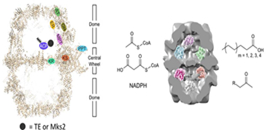 02 24, 2017Researchers Expand Product Portfolio of Fatty Acid Biosynthetic MachineryIn the current study, Prof. ZHAO teamed up with Prof. Nielsen Jens of Chalmers University of Technology and Prof. Grininger, demonstrated that duplicated ACP in RtFAS are redundant in terms of fatty acid biosynthesis. Researchers replaced either ACP with a short chain thioesterase (TE) from bacteria and showed that the engineered RtFAS can overproduce short/medium chain fatty acids. Similarly, when either ACP was replaced by a methylketone synthase (Mks2), the engineered RtFAS produced long chain methyl ketones. Importantly, this modification strategy was generalized towards other fungal type I FASs, and various modified FASs showed new functions as expected (Nat. Chem. Biol., doi:10.1038/nchembio.2301). This study facilitated new opportunities to engineer fatty acid biosynthetic machinery for expanded product portfolio.
02 24, 2017Researchers Expand Product Portfolio of Fatty Acid Biosynthetic MachineryIn the current study, Prof. ZHAO teamed up with Prof. Nielsen Jens of Chalmers University of Technology and Prof. Grininger, demonstrated that duplicated ACP in RtFAS are redundant in terms of fatty acid biosynthesis. Researchers replaced either ACP with a short chain thioesterase (TE) from bacteria and showed that the engineered RtFAS can overproduce short/medium chain fatty acids. Similarly, when either ACP was replaced by a methylketone synthase (Mks2), the engineered RtFAS produced long chain methyl ketones. Importantly, this modification strategy was generalized towards other fungal type I FASs, and various modified FASs showed new functions as expected (Nat. Chem. Biol., doi:10.1038/nchembio.2301). This study facilitated new opportunities to engineer fatty acid biosynthetic machinery for expanded product portfolio.
Fatty acids are essential for life, and useful for production of biofuels and diverse oleochemicals. To synthesize fatty acid from small metabolites, nature develops complicated biosynthetic machinery. Among fatty acid synthases (FASs) found in nature, the fungal type I FASs are the most efficient, because of the spatial proximity of all seven catalytic enzyme domains (AT, ER, DH, MPT, KS, KR, PPT) and a tethered acyl-carrier protein (ACP) domain. As fungal type I FASs have all catalytic centers embedded into a complicated scaffolding matrix, it remains challenging to manipulate them for new function.
During an on-going project studying molecular bases of lipid overproduction by oleaginous yeasts, Prof. ZHAO Zongbao and his co-workers at Dalian Institute of Chemical Physics, CAS, found that the red yeast Rhodosporidium toruloides contains a novel FAS, RtFAS, with two ACPs and unusual genetic structure (Nat. Commun. 2012, 3, 1112). However, Prof. Grininger Martin of Goethe University Frankfurt and Prof. ZHAO later showed that RtFAS assembles into the typical fungal FAS structure by cryo-electron microscopy analysis (Protein Sci. 2015, 24, 987).
Design and strategy for engineering fungal fatty acid synthases (FASs) to synthesize tailored oleochemicals (Image by ZHU Zhiwei)
In the current study, Prof. ZHAO teamed up with Prof. Nielsen Jens of Chalmers University of Technology and Prof. Grininger, demonstrated that duplicated ACP in RtFAS are redundant in terms of fatty acid biosynthesis. Researchers replaced either ACP with a short chain thioesterase (TE) from bacteria and showed that the engineered RtFAS can overproduce short/medium chain fatty acids. Similarly, when either ACP was replaced by a methylketone synthase (Mks2), the engineered RtFAS produced long chain methyl ketones. Importantly, this modification strategy was generalized towards other fungal type I FASs, and various modified FASs showed new functions as expected (Nat. Chem. Biol., doi:10.1038/nchembio.2301). This study facilitated new opportunities to engineer fatty acid biosynthetic machinery for expanded product portfolio.
This work was financially supported by National Natural Foundation of China (21325627). (Text and Image by ZHU Zhiwei)
Dr. LU Xinyi
Dalian Institute of Chemical Physics, Chinese Academy of Sciences,
457 Zhongshan Road, Dalian, 116023, China,
Tel: 86-411-84379201
E-mail: luxinyi@dicp.ac.cn
-
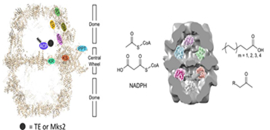 02 24, 2017Researchers Expand Product Portfolio of Fatty Acid Biosynthetic MachineryIn the current study, Prof. ZHAO teamed up with Prof. Nielsen Jens of Chalmers University of Technology and Prof. Grininger, demonstrated that duplicated ACP in RtFAS are redundant in terms of fatty acid biosynthesis. Researchers replaced either ACP with a short chain thioesterase (TE) from bacteria and showed that the engineered RtFAS can overproduce short/medium chain fatty acids. Similarly, when either ACP was replaced by a methylketone synthase (Mks2), the engineered RtFAS produced long chain methyl ketones. Importantly, this modification strategy was generalized towards other fungal type I FASs, and various modified FASs showed new functions as expected (Nat. Chem. Biol., doi:10.1038/nchembio.2301). This study facilitated new opportunities to engineer fatty acid biosynthetic machinery for expanded product portfolio.
02 24, 2017Researchers Expand Product Portfolio of Fatty Acid Biosynthetic MachineryIn the current study, Prof. ZHAO teamed up with Prof. Nielsen Jens of Chalmers University of Technology and Prof. Grininger, demonstrated that duplicated ACP in RtFAS are redundant in terms of fatty acid biosynthesis. Researchers replaced either ACP with a short chain thioesterase (TE) from bacteria and showed that the engineered RtFAS can overproduce short/medium chain fatty acids. Similarly, when either ACP was replaced by a methylketone synthase (Mks2), the engineered RtFAS produced long chain methyl ketones. Importantly, this modification strategy was generalized towards other fungal type I FASs, and various modified FASs showed new functions as expected (Nat. Chem. Biol., doi:10.1038/nchembio.2301). This study facilitated new opportunities to engineer fatty acid biosynthetic machinery for expanded product portfolio.
Fatty acids are essential for life, and useful for production of biofuels and diverse oleochemicals. To synthesize fatty acid from small metabolites, nature develops complicated biosynthetic machinery. Among fatty acid synthases (FASs) found in nature, the fungal type I FASs are the most efficient, because of the spatial proximity of all seven catalytic enzyme domains (AT, ER, DH, MPT, KS, KR, PPT) and a tethered acyl-carrier protein (ACP) domain. As fungal type I FASs have all catalytic centers embedded into a complicated scaffolding matrix, it remains challenging to manipulate them for new function.
During an on-going project studying molecular bases of lipid overproduction by oleaginous yeasts, Prof. ZHAO Zongbao and his co-workers at Dalian Institute of Chemical Physics, CAS, found that the red yeast Rhodosporidium toruloides contains a novel FAS, RtFAS, with two ACPs and unusual genetic structure (Nat. Commun. 2012, 3, 1112). However, Prof. Grininger Martin of Goethe University Frankfurt and Prof. ZHAO later showed that RtFAS assembles into the typical fungal FAS structure by cryo-electron microscopy analysis (Protein Sci. 2015, 24, 987).
Design and strategy for engineering fungal fatty acid synthases (FASs) to synthesize tailored oleochemicals (Image by ZHU Zhiwei)
In the current study, Prof. ZHAO teamed up with Prof. Nielsen Jens of Chalmers University of Technology and Prof. Grininger, demonstrated that duplicated ACP in RtFAS are redundant in terms of fatty acid biosynthesis. Researchers replaced either ACP with a short chain thioesterase (TE) from bacteria and showed that the engineered RtFAS can overproduce short/medium chain fatty acids. Similarly, when either ACP was replaced by a methylketone synthase (Mks2), the engineered RtFAS produced long chain methyl ketones. Importantly, this modification strategy was generalized towards other fungal type I FASs, and various modified FASs showed new functions as expected (Nat. Chem. Biol., doi:10.1038/nchembio.2301). This study facilitated new opportunities to engineer fatty acid biosynthetic machinery for expanded product portfolio.
This work was financially supported by National Natural Foundation of China (21325627). (Text and Image by ZHU Zhiwei)
Dr. LU Xinyi
Dalian Institute of Chemical Physics, Chinese Academy of Sciences,
457 Zhongshan Road, Dalian, 116023, China,
Tel: 86-411-84379201
E-mail: luxinyi@dicp.ac.cn
-
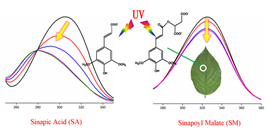 02 24, 2017Scientists find The Photoprotection Mechanism of Plant SunscreenTo understand the photoprotection mechanism, Prof. HAN Keli and his coworkers at Dalian Institute of Chemical Physics, CAS, use the femtosecond transient absorption spectroscopy and time-dependent density functional theory and find the ultrafast photoisomerization mechanism of SA and SM in neutral aqueous solution.
02 24, 2017Scientists find The Photoprotection Mechanism of Plant SunscreenTo understand the photoprotection mechanism, Prof. HAN Keli and his coworkers at Dalian Institute of Chemical Physics, CAS, use the femtosecond transient absorption spectroscopy and time-dependent density functional theory and find the ultrafast photoisomerization mechanism of SA and SM in neutral aqueous solution.
Ultraviolet irradiation can induce DNA damages. Plants suffer much more sunlight than animals. As a result, nature has selected efficient screening agents to protect plants. In adult Arabidopsis plants, sinapoyl malate (SM) is deposited in the leaf epidermis to prevent penetration of UV radiation, which is an ester derivative of sinapic acid (SA). However, the photoprotection mechanism of sinpoyl malate in aqueous solution is still unknown.
To understand the photoprotection mechanism, Prof. HAN Keli and his coworkers at Dalian Institute of Chemical Physics, CAS, use the femtosecond transient absorption spectroscopy and time-dependent density functional theory and find the ultrafast photoisomerization mechanism of SA and SM in neutral aqueous solution.
The Photoprotection Mechanism of Plant Sunscreen (Image by LUO Jian)
In the neutral aqueous solution, both SM and SA are deprotonated. Their excited states can relax to the ground states by ultrafast barrierless trans-cis photoisomerization, efficiently dissipating the ultraviolet energy into surroundings. However, the cis deprotonated SA has much lower ultraviolet absorption ability compared to its trans conformer. In contrast, the cis deprotonated SM still absorbs ultraviolet light strongly. Furthermore, the excited-state protonated SA can also decay to the ground state by ultrafast photoisomerization and its cis product still has strong ultraviolet absorption ability. Therefore, the protonated SA can be used as a new sunscreen molecule after proper chemical modification.
The related work was published on the Journal of Physical Chemistry Letters. This study was financially supported by National Basic Research Program of China and the National Natural Science Foundation of China. (Text and Image by LUO Jian)
Contact:
Dr. LU Xinyi
Dalian Institute of Chemical Physics, Chinese Academy of Sciences,
457 Zhongshan Road, Dalian, 116023, China,
Tel: 86-411-84379201
E-mail: luxinyi@dicp.ac.cn -
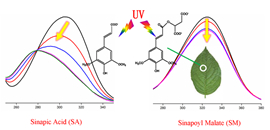 02 24, 2017Scientists find The Photoprotection Mechanism of Plant SunscreenTo understand the photoprotection mechanism, Prof. HAN Keli and his coworkers at Dalian Institute of Chemical Physics, CAS, use the femtosecond transient absorption spectroscopy and time-dependent density functional theory and find the ultrafast photoisomerization mechanism of SA and SM in neutral aqueous solution.
02 24, 2017Scientists find The Photoprotection Mechanism of Plant SunscreenTo understand the photoprotection mechanism, Prof. HAN Keli and his coworkers at Dalian Institute of Chemical Physics, CAS, use the femtosecond transient absorption spectroscopy and time-dependent density functional theory and find the ultrafast photoisomerization mechanism of SA and SM in neutral aqueous solution.
Ultraviolet irradiation can induce DNA damages. Plants suffer much more sunlight than animals. As a result, nature has selected efficient screening agents to protect plants. In adult Arabidopsis plants, sinapoyl malate (SM) is deposited in the leaf epidermis to prevent penetration of UV radiation, which is an ester derivative of sinapic acid (SA). However, the photoprotection mechanism of sinpoyl malate in aqueous solution is still unknown.
To understand the photoprotection mechanism, Prof. HAN Keli and his coworkers at Dalian Institute of Chemical Physics, CAS, use the femtosecond transient absorption spectroscopy and time-dependent density functional theory and find the ultrafast photoisomerization mechanism of SA and SM in neutral aqueous solution.
The Photoprotection Mechanism of Plant Sunscreen (Image by LUO Jian)
In the neutral aqueous solution, both SM and SA are deprotonated. Their excited states can relax to the ground states by ultrafast barrierless trans-cis photoisomerization, efficiently dissipating the ultraviolet energy into surroundings. However, the cis deprotonated SA has much lower ultraviolet absorption ability compared to its trans conformer. In contrast, the cis deprotonated SM still absorbs ultraviolet light strongly. Furthermore, the excited-state protonated SA can also decay to the ground state by ultrafast photoisomerization and its cis product still has strong ultraviolet absorption ability. Therefore, the protonated SA can be used as a new sunscreen molecule after proper chemical modification.
The related work was published on the Journal of Physical Chemistry Letters. This study was financially supported by National Basic Research Program of China and the National Natural Science Foundation of China. (Text and Image by LUO Jian)
Contact:
Dr. LU Xinyi
Dalian Institute of Chemical Physics, Chinese Academy of Sciences,
457 Zhongshan Road, Dalian, 116023, China,
Tel: 86-411-84379201
E-mail: luxinyi@dicp.ac.cn -
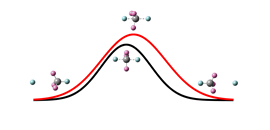 02 20, 2017Researchers Find Insight into the Simplest Substitution Reaction via Walden Inversion MechanismA research term led by prof. ZHANG Donghui from State Key Laboratory of Molecular Reaction Dynamics, Dalian Institute of Chemical Physics, Chinese Academy of Sciences has carried out an accurate quantum dynamics study of the H'+CH4→CH3H'+H substitution reaction and its isotope analogies.
02 20, 2017Researchers Find Insight into the Simplest Substitution Reaction via Walden Inversion MechanismA research term led by prof. ZHANG Donghui from State Key Laboratory of Molecular Reaction Dynamics, Dalian Institute of Chemical Physics, Chinese Academy of Sciences has carried out an accurate quantum dynamics study of the H'+CH4→CH3H'+H substitution reaction and its isotope analogies.
Reactions occurring at a carbon atom with a tetrahedral environment proceeding through the back-side attack Walden inversion mechanism are one of the most important and useful classes of reactions in chemistry. The bimolecular nucleophilic substitution (SN2) reaction is the most common reaction of that type. In a SN2 reaction, a nucleophile approaches a saturated carbon from one side, displaces a leaving group on the opposite side of the carbon atom, resulting in inversion of the carbon center. Decades of extensive studies revealed that a gas-phase SN2 reaction with a center barrier exhibits an inverse secondary kinetic isotope effect (KIE) on thermal rate constant at room temperature, i.e. kH/kD < 1 when isotopically substituted atom not directly involved in the reaction. In contrast, on the cross sections it shows a large normal secondary isotope effect with reaction threshold energy substantially higher than calculated barrier height. However, the origin of this intriguing difference on the isotope effects on the kinetic and cross sections as well as the high energy threshold remain unclear.
A research term led by prof. ZHANG Donghui from State Key Laboratory of Molecular Reaction Dynamics, Dalian Institute of Chemical Physics, Chinese Academy of Sciences has carried out an accurate quantum dynamics study of the H' + CH4 → CH3H' + H substitution reaction and its isotope analogies. The reaction is the simplest reaction proceeding through the back-side attack Walden inversion mechanism, with a D3h transition state and a static barrier height of 1.6 eV. It is very similar to the gas-phase SN2 reactions with central barriers, except that there exist pre- and post-reaction wells in SN2 reactions stemming from strong ion-dipole interaction between reagents/products. They found that the reaction threshold energy is considerably higher than the barrier height, and the reaction manifests different isotope effect. In term of cross section beyond reaction threshold energy, it has a large normal secondary isotope effect with the reactivity for the H' + CH4 → CH3H' + H reaction substantially larger than that for H' + CHD3 → CD3H' + H reaction. However, in term of thermal rate constant it has a reverse secondary KIE with the rate for H + CH4 slightly smaller than that for H + CHD3.
In order to explore the dynamics origin of these different isotope effects, they analyzed the change of the umbrella angle of the non-reacting methyl group as the reaction proceeds. According to the minimum energy path (MEP), the umbrella angle should change synchronously during the reaction with the incoming of H atom and elongation of the breaking CH bond to reach 90° at the static saddle point. However, it turned out that for the H' + CHD3 substitution reaction the umbrella motion of the non-reacting CD3 group is slow in responding to the attack of the incoming H atom during the reaction. The reaction does not proceed along MEP as shown by the black reaction path in the figure. Instead, it proceeds on the red path with the umbrella angle larger than 90° at the dynamical saddle point and the corresponding barrier height higher than the static barrier height. Because the umbrella motion depends on the masses of the methyl group, isotope replacement of D atom to H atom can enhance the reactivity substantially, resulting in a large normal isotope effect on cross sections. Furthermore, because the initial umbrella excitation of methyl group can accelerate the umbrella motion during reaction substantially, it can dramatically enhance the reactivity. As a result, the thermal rate constant for the reaction is exclusively determined by the contributions from the umbrella excited states. As the contributions from the umbrella excited states for the H + CD3H reaction beat those for the H + CH4 reaction, the reaction exhibits an inverse secondary KIE.
All the phenomena found from this study for the H+CH4 substitution reactions, including higher threshold energy, a reverse secondary KIE at room temperature, and a large normal isotope effect for reaction cross section, have been observed for gas-phase SN2 reactions with barriers. We anticipate that the mechanisms uncovered from this study play important roles in these gas-phase SN2 reactions. Therefore, this study only not represents the first accurate theoretical study of a Walden inversion reaction which provided unprecedented dynamical details and a clear physical picture of the dynamics, but also sheds light on the dynamics of gas-phase SN2 reactions.
H' + CH4 → CH3H' + H substitution reaction (Image by ZHANG Donghui)
The related work was published in Nature Communications entitled as “Dynamical barrier and isotope effects in the simplest substitution reaction via Walden inversion mechanism”. This study was financially supported by the Natural Science Foundation of China, Ministry of Science and Technology of China, and the Chinese Academy of Sciences. (Text and Image by ZHANG Donghui) (CN 约稿)
Contact:
Dr. LU Xinyi
Dalian Institute of Chemical Physics, Chinese Academy of Sciences,
457 Zhongshan Road, Dalian, 116023, China,
Tel: 86-411-84379201
E-mail: luxinyi@dicp.ac.cn
-
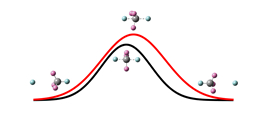 02 20, 2017Researchers Find Insight into the Simplest Substitution Reaction via Walden Inversion MechanismA research term led by prof. ZHANG Donghui from State Key Laboratory of Molecular Reaction Dynamics, Dalian Institute of Chemical Physics, Chinese Academy of Sciences has carried out an accurate quantum dynamics study of the H'+CH4→CH3H'+H substitution reaction and its isotope analogies.
02 20, 2017Researchers Find Insight into the Simplest Substitution Reaction via Walden Inversion MechanismA research term led by prof. ZHANG Donghui from State Key Laboratory of Molecular Reaction Dynamics, Dalian Institute of Chemical Physics, Chinese Academy of Sciences has carried out an accurate quantum dynamics study of the H'+CH4→CH3H'+H substitution reaction and its isotope analogies.
Reactions occurring at a carbon atom with a tetrahedral environment proceeding through the back-side attack Walden inversion mechanism are one of the most important and useful classes of reactions in chemistry. The bimolecular nucleophilic substitution (SN2) reaction is the most common reaction of that type. In a SN2 reaction, a nucleophile approaches a saturated carbon from one side, displaces a leaving group on the opposite side of the carbon atom, resulting in inversion of the carbon center. Decades of extensive studies revealed that a gas-phase SN2 reaction with a center barrier exhibits an inverse secondary kinetic isotope effect (KIE) on thermal rate constant at room temperature, i.e. kH/kD < 1 when isotopically substituted atom not directly involved in the reaction. In contrast, on the cross sections it shows a large normal secondary isotope effect with reaction threshold energy substantially higher than calculated barrier height. However, the origin of this intriguing difference on the isotope effects on the kinetic and cross sections as well as the high energy threshold remain unclear.
A research term led by prof. ZHANG Donghui from State Key Laboratory of Molecular Reaction Dynamics, Dalian Institute of Chemical Physics, Chinese Academy of Sciences has carried out an accurate quantum dynamics study of the H' + CH4 → CH3H' + H substitution reaction and its isotope analogies. The reaction is the simplest reaction proceeding through the back-side attack Walden inversion mechanism, with a D3h transition state and a static barrier height of 1.6 eV. It is very similar to the gas-phase SN2 reactions with central barriers, except that there exist pre- and post-reaction wells in SN2 reactions stemming from strong ion-dipole interaction between reagents/products. They found that the reaction threshold energy is considerably higher than the barrier height, and the reaction manifests different isotope effect. In term of cross section beyond reaction threshold energy, it has a large normal secondary isotope effect with the reactivity for the H' + CH4 → CH3H' + H reaction substantially larger than that for H' + CHD3 → CD3H' + H reaction. However, in term of thermal rate constant it has a reverse secondary KIE with the rate for H + CH4 slightly smaller than that for H + CHD3.
In order to explore the dynamics origin of these different isotope effects, they analyzed the change of the umbrella angle of the non-reacting methyl group as the reaction proceeds. According to the minimum energy path (MEP), the umbrella angle should change synchronously during the reaction with the incoming of H atom and elongation of the breaking CH bond to reach 90° at the static saddle point. However, it turned out that for the H' + CHD3 substitution reaction the umbrella motion of the non-reacting CD3 group is slow in responding to the attack of the incoming H atom during the reaction. The reaction does not proceed along MEP as shown by the black reaction path in the figure. Instead, it proceeds on the red path with the umbrella angle larger than 90° at the dynamical saddle point and the corresponding barrier height higher than the static barrier height. Because the umbrella motion depends on the masses of the methyl group, isotope replacement of D atom to H atom can enhance the reactivity substantially, resulting in a large normal isotope effect on cross sections. Furthermore, because the initial umbrella excitation of methyl group can accelerate the umbrella motion during reaction substantially, it can dramatically enhance the reactivity. As a result, the thermal rate constant for the reaction is exclusively determined by the contributions from the umbrella excited states. As the contributions from the umbrella excited states for the H + CD3H reaction beat those for the H + CH4 reaction, the reaction exhibits an inverse secondary KIE.
All the phenomena found from this study for the H+CH4 substitution reactions, including higher threshold energy, a reverse secondary KIE at room temperature, and a large normal isotope effect for reaction cross section, have been observed for gas-phase SN2 reactions with barriers. We anticipate that the mechanisms uncovered from this study play important roles in these gas-phase SN2 reactions. Therefore, this study only not represents the first accurate theoretical study of a Walden inversion reaction which provided unprecedented dynamical details and a clear physical picture of the dynamics, but also sheds light on the dynamics of gas-phase SN2 reactions.
H' + CH4 → CH3H' + H substitution reaction (Image by ZHANG Donghui)
The related work was published in Nature Communications entitled as “Dynamical barrier and isotope effects in the simplest substitution reaction via Walden inversion mechanism”. This study was financially supported by the Natural Science Foundation of China, Ministry of Science and Technology of China, and the Chinese Academy of Sciences. (Text and Image by ZHANG Donghui) (CN 约稿)
Contact:
Dr. LU Xinyi
Dalian Institute of Chemical Physics, Chinese Academy of Sciences,
457 Zhongshan Road, Dalian, 116023, China,
Tel: 86-411-84379201
E-mail: luxinyi@dicp.ac.cn